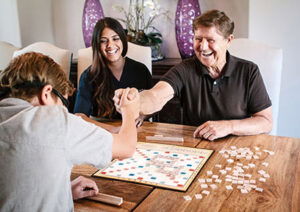Until 100 years ago, many people never traveled more than 10 miles from the home in which they were born or lived in when they got married, which was usually down the street or the next farm over. Families remained grouped together for many reasons, including having emigrated from a foreign country and starting a new life together. There was strength in numbers: both economic advantages and in perpetuating long-held traditions that would tie loved ones together in the face of new challenges. Where seniors were concerned, the expectation that younger family members would always care for them was implied—and something not all that difficult if people were living within steps of one another.
Clearly things have changed, and adult children can be hundreds and thousands of miles away from aging parents. This can make it challenging to determine changes in physical, mental and emotional health, often leading to stress and guilt. While long-distance caregiving isn’t always the answer, there are things families can do to help ensure their senior loved one’s needs are monitored and met.
1 Hold a Family Meeting to Plan In-Home Care for a Senior Loved One
First, organizationally, if there are multiple adult children and other family members that can provide long-distance care, have a family meeting—in person or video chat—to decide what everyone’s strengths and skillsets are and what their availability is. Tantamount to that, realistically evaluate how much each can do, knowing that a trusted neighbor or someone else outside the family and local to the senior may need to be hired to fill in any gaps.
If a family member is better at managing finances, for example, s/he should assume that responsibility when the time comes, always with written permission. A Merrill Lynch study revealed about 92 percent of family caregivers are managing their loved one’s finances, including monitoring and paying bills from bank accounts, handling insurance claims, filing taxes, and overseeing investments.
2 Communicate with Your Aging Loved One Every Day
It’s important to check in with an aging parent every day, even several times a day depending on the state of health, particularly if that individual lives alone. If the senior is adept at technology, FaceTime or other forms of video chat are always preferable as visuals are a useful tool in gauging changes. Today there are a variety of simpler forms of senior-friendly video call apps and devices available. These include but are not limited to the Jitterbug Smart3, GrandPad, and CallGenie (British-based product now available in the U.S.).
3 Connect Regularly with Your Beloved Senior’s Healthcare Providers
Schedule regular calls with physicians, visiting nurses, and/or others for up-to-date information about you loved one’s health and evolving needs. If an in-home senior care agency is involved, consistent updates should be part of the protocol.
4 Set Up a Personal Emergency Response System to Maintain a Senior’s Independence
Sometimes dubbed high-tech guardian angels, personal emergency response systems (PERS) support safe and independent living. At the touch of a button (or in some cases by voice activation) an immediate notification is sent to first responders when a fall or other medical emergency is detected. PERS devices can be worn by the senior as a pendant, or a unit can be set up strategically inside the home to provide 24/7 monitoring services.
5 Obtain a Smart Pill Dispenser for Medication Management
As people age, memory can be affected with issues that include failure to take medication or not recalling if a dose was taken or not. Multiple medications are also a byproduct of aging and facing an array of bottles every day can be confusing and disorienting for seniors. A user-friendly solution lies in medication management with automatic pill dispensers, as these smart devices for healthcare can do so much more than hold apportioned pills in a little plastic box. Smart pill devices organize medications and ensure the correct dose is dispensed at the right time, and some can also notify the caregiver if a dose is missed.
6 Explore Alternative Senior Living Arrangements
Is an aging parent amenable to moving closer to adult children? Independent living and assisted living fall under the broad banner of senior living communities and can make the stress that accompanies long-distance caregiving a thing of the past. Many seniors and their families are unsure where to start their search for assisted living and other senior housing options.
7 Plan More Frequent Visits to Keep Tabs on Your Elderly Loved One’s Welfare
Work, raising families, community responsibilities, and everything else can make life overwhelming today. But if a parent or grandparent is aging, there’s no better way to monitor needs than to visit as often as possible—even for a long weekend now and then. If there are multiple adult siblings or young adult grandchildren, spreading the visits out among family members can ease the burden of constant traveling and help ensure changes in health and mobility do not go undetected.
Besides, the opportunity to spend time with mom or dad in their sunset years is precious, and something you will never have again. In your effort to monitor things and provide support, which no one argues can be time consuming and stressful, make sure to slow down and listen. As the saying goes, “When a senior dies, a library closes.”
8 Ask for Information and Guidance from a Trusted Senior Resource
Know that an Amada Senior Care advisor has the expertise and knowledge to assist without obligation as families with aging loves ones navigate their senior care journey. Click HERE to find an Amada office near you or call (866) 752-1961.
“8 Tips for Family Members Caring for a Senior Loved One from Far Away,” written by Beth Herman, Amada Blog contributor.















